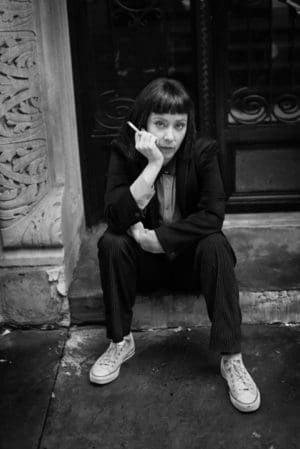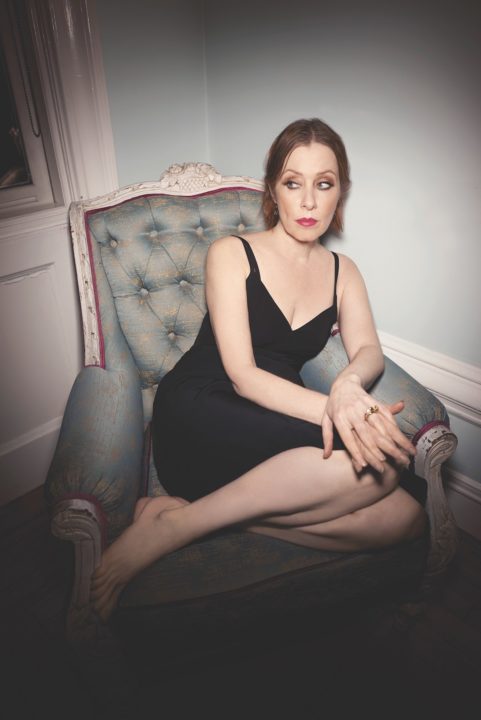Singer-songwriter Suzanne Vega meets Dave Steinfeld in the Big Apple to look back on her acclaimed career and explain how she’s regained some control over her back catalogue…
Considering that her most enduring song is about a diner, it makes sense that Suzanne Vega would ask us to meet at one for her Classic Pop interview. The problem – as anyone who has been to New York City diners knows – is that they’re not exactly the ideal setting when you’re planning to record someone’s voice. So instead, we revert to Plan B and meet at a lovely but suitably sparsely populated Italian restaurant.
Vega was one of the most acclaimed singer-songwriters to emerge in the 80s, scoring hits with literate songs like Luka, Marlene On The Wall and, of course, Tom’s Diner. Though she was born in California, Vega’s family moved to New York City when she was young and settled in Spanish Harlem. As a teen, she attended the High School Of Performing Arts and began writing songs.
Her self-titled debut came out in 1985; critically acclaimed, it sold well enough to ensure a follow-up, while Marlene On The Wall became a hit in the UK.
She returned two years later with Solitude Standing, the album that made her a star. Luka was all over the radio and suddenly, Vega went from playing intimate Greenwich Village coffee houses to large, prestigious venues like Carnegie Hall.
“I was turned down for not having enough experience, for not really fitting in… we sent demos to all the big labels. All of them said ‘no’. One of them said I had ‘no sense of melody’” – Suzanne Vega
“It was bewildering,” Vega says today. “The bewildering thing was that I had been doing it for 10 years already. I started performing in the city when I was 16, going to auditions, and often I was turned down for not having enough experience, for not really fitting in with what was popular in the 70s… it was years and years of people going, ‘no thank you’. Suddenly, one person says ‘yes’ and then another person says ‘yes’… and it started to snowball.”
Indeed, though Luka became a smash in 1987, the groundwork for Vega’s success was, in fact, laid years earlier.
“In 1981 or early ’82, I met [managers] Ron Fierstein and Steve Addabbo,” she remembers. “We started working on a demo… it took a couple of years because we all had day jobs. I would meet with Steve whenever there was studio time available. We worked on those tapes and sent them to not only A&M but all the big labels. All of them said ‘no’ – including A&M. A&M said ‘no’ twice! One of the letters said I had ‘no sense of melody’.”
Everything changed for Vega on the day a writer called Stephen Holden reviewed her in the New York Times. “Suddenly, we got a call from A&M – and a call from David Geffen! They said, ‘How come you haven’t sent us your tape?’ And Ron said, ‘Actually, we did. You turned it down.’ So we knew we wanted to go with A&M, and in the end we went there. But there was a nice little bidding war between A&M and Geffen. That happened in ’84.
“So, I was finally signed to A&M, and they expected to sell 30,000 copies of the first album – total. I sold 17,000 the first week! And I remember thinking, wow! And it just kept selling. It sold a few thousand every week and kept going, until I had sold a million around the world. We built up this momentum, and then it kept going with the second album.”
Pop_Up
The ‘real’ Luka was a child who lived in the same building as Vega around 1984, but he was not a victim of abuse: she just used the name. “He probably did live upstairs, though,” she explains. “Everybody did… I was on the ground floor.”
1990 was a big year for Vega. She released her long-awaited third album, Days Of Open Hand. Though not a groundbreaking event on the level of Solitude Standing, it was still well received and produced the hit Book Of Dreams. Then, later that year, producers DNA scored a leftfield smash with their remix of Tom’s Diner and as a result, Vega unwittingly, and unexpectedly, became something of a name in the genre of electronica.
She still recalls how she found out about the DNA version. “I first heard about it because my manager had been told by A&M that there had been a remix – unauthorised. A&M was not happy about it. I was nervous that it was going to be a parody – I do not like parodies!
“We were on vacation and my nine-year-old daughter said, ‘Mom, why are you wearing all black? We’re at the beach!’ She said, ‘You look so emo!’ And she didn’t mean it in a good way” – Suzanne Vega
There had been a lot of parodies of Luka and I was worried that this was gonna be the same thing. But instead, what I found was this really cool remix! It was still the song, still my voice, the lyrics were the same. They had just put this beat behind it, and this chorus. I loved it!
“So I said to Ron, ‘Why don’t we buy it from them, and release it ourselves through A&M?’ So we bought it from them for a relatively low price, and released it worldwide.
“DNA was made up of two people,” Vega adds. “One was the actual artist, the remixer, Nick Batt. He still works today, with Goldfrapp [and others]. The other one is Neal Slateford, who did all the marketing and had the ideas. The first time I met them, it was very funny. I was in London, I guess, and they flew down to meet us. I had assumed they were black, so when the two of them walked in the room, I thought they were the accountant and the manager. Nick is one of the whitest guys you’ll ever meet; he’s the one I thought was the accountant. Neal is chunkier, with curly hair, a little more blustery. And I thought, ‘Oh, that must be the manager.’
“I kept looking around to see where the real DNA were – and it turned out to be them! But I liked them so much… I’m still friends with them.”
Vega says that the success of the Tom’s Diner remix gave her the confidence to be more experimental on her next release, 99.9F°, but adds: “It was a direction I was heading in anyway. When I hired Mitchell Froom, I was looking for someone who was a classic pop producer.
“The first song we worked on was Blood Makes Noise. All I had were the lyrics and a vague notion of fast guitars, like the Ramones or something. So I just sang the words into the air, he recorded it and the next day, when I came in, he had that crashing-anvil sound – that sort of techno, Trent Reznor sound. I loved it! The sonic difference between Days Of Open Hand and 99.9F° was like going from fine pencil work to big colourful crayons.”
She and Froom connected personally as well; they wound up getting married, and their daughter Ruby was born in 1994.
Between 99.9F° and her new album Lover Beloved, Vega released four more studio efforts. Nine Objects Of Desire came out in 1996, Songs In Red And Gray (some of which chronicles her and Froom’s divorce) was released five years later, and Beauty & Crime appeared in 2007.
This latter album was very well-received, and for good reason: though it comes in at just over half an hour long, Beauty & Crime is both musically diverse and an extremely personal work. It deals largely with September 11 and with the death nine months later of Vega’s brother, Tim. But there are also love songs — both to Ruby and to Suzanne’s current husband, Paul.
In 2014, she unveiled Tales From The Realm Of The Queen Of Pentacles, the long-awaited follow-up, but between studio albums, something else happened: Vega put together the Close Up series, four separate CDs that consist mainly of new, stripped-down recordings of older songs and which are arranged by theme. One reason she did this was to try to take control of her back catalogue.
“In 2007, I made Beauty & Crime,” she says. “I had what I thought was a great relationship with Blue Note. I had a great relationship with [label owner] Bruce Lundvall. I felt very solidly backed by him, but then, in 2008, I was dropped! Blue Note dropped me on my face. The album won a Grammy! And I was still sort of shown the back door…”

Vega pictured for her latest release, ‘Lover, Beloved’
“So I was really upset and stunned by being dropped at that point. I had only been with them for two years. I really thought we were in it for the long haul. So what was I going to do? I didn’t feel confident enough to write a bunch of songs to try to get another major label deal. I didn’t even feel like writing a bunch of songs and putting them out myself… to what audience?
“I was just starting to play around with Facebook at that time,” she continues. “I remember thinking, ‘I have nothing. I don’t even have my old albums; those belong to A&M. So they could sit on the floor for the rest of my life. I have no control of that.’ I wanted to have control over something.
“So I thought, ‘Let me start my own record company by doing these re-recordings. I’ll do them by theme, so people who only know the first two albums can see all the other writing I’ve done. And I’ll grow my website, my Facebook page, my Twitter feed. That way, I’ll have a group of people to market to and I’ll have something to sell at gigs.’ And that part of it did work.”
Vega returned in October 2016 with a new studio album, Lover, Beloved. Subtitled Songs From An Evening With Carson McCullers, it’s a concept album about the late, troubled novelist credited by many as inventing the Southern Gothic literary genre.
Pop_Up
Vega’s collaborators on Lover, Beloved are theatre composer Duncan Sheik, who had a hit in the 90s with Barely Breathing, and her longtime guitarist Gerry Leonard, who produced the record.
With just 10 songs, it’s a concise offering – but Vega employs a variety of tempos, styles and instruments on the album (a few tracks feature banjo, while others feature brass). Highlights range from the Bacharachian New York Is My Destination to the funny, upbeat Harper Lee to the lovely ballad Annemarie, which was written about Annemarie Schwarzenbach, a woman with whom McCullers was romantically involved (she was bisexual). The album’s songs are meant to preview a second play, which will be staged sometime this year.
Although the album is new, Vega’s fascination with Carson McCullers dates back more than 40 years. She first discovered McCullers as a teenager when she read a short story called Sucker.
“The language was tough and real,” she tells us. “I liked her use of slang and the relationship between the two main characters – both male, by the way. The dynamic between the two adolescent boys – how at first one holds the power and then how it switches to the other one – is fascinating.”
In college, Vega delved more deeply into McCullers’ work and five years ago, she played her in Carson McCullers Talks About Love, a one-woman show at the Rattlestick Playwrights Theater in lower Manhattan. What keeps drawing Vega back to McCullers?
“Two things,” she replies. “One is that I just wasn’t finished [after the play]. I’m hoping that this will be the final play – and then I can let go. But I need to go back to her so that I can finish what I started, and get it out to the best of my ability.
“But two: she’s worth going back to, because she’s timely… she’s sort of working toward an ideology of unconditional love and humanity. And in doing so, she reaches out to all these very imperfect humans – which, of course, is what we all are. So whether she’s writing about blacks or Jews or people of varying sexualities, it was timely in the ‘60s because of the struggles with civil rights.
“And it’s timely now. Because of Black Lives Matter, because of the violence perpetrated by the police and now, of course, because after the most recent election, all kinds of people are in danger from our President. I mean, that vision of transcendent love that she preaches… is still timely and necessary. And I think it will be more so in the next four years.”
Classic Pop may earn commission from the links on this page, but we only feature products we think you will enjoy.




